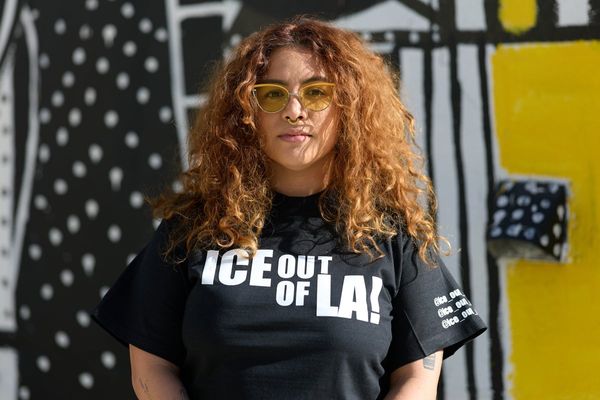
It’s like a pimple from the underworld. OK, not a carbuncle from the netherworld, but nonetheless a slow-stomach-churning vision of horrors imagined and possibly yet to come. That is to say: food poisoning.
“Most of the time, when you get food poisoning from restaurants, it’s from something like this,” said @loony_jolb15 in his cautionary TikTok video.
He gently squeezes a Carl’s Jr. Buttermilk ranch container. Then an opaque white blob of dressing oozes out of the far corner of the small tub.
“[You] hold it in your hand, it looks really good,” he said as he held it at various angles. “Give it a little squeeze and then guess what? It’s actually leaking.”
In a follow-up email, @loony_jolb15 explained that he had gotten ill with food poisoning once. He thinks Domino’s Pizza was the culprit. Then, on the day he made the TikTok, he noticed something that made him connect the dots.
“I had ordered French fries from Carl’s Jr., and on the outside of the ranch packet, I saw what looked like some curdled ranch,” he said. “You can even see it in the video, though I didn’t go too in-depth there because I wanted to keep it quick.”
Out of curiosity, he squeezed the packet just a bit, and the dressing squirted out the side, he said.
“Right away I thought, ‘Wait, what if that’s how I got food poisoning that one time from Domino’s?’”
He said he had never considered it before, and then realized that maybe other people haven’t either. “If you just squeeze the packet a little before opening it, you can actually spot a leak and potentially avoid a food poisoning disaster.”
Ranch as a fan-favorite
In America, ranch dressing is in the top five of the most popular condiments on the table. This includes mayo and ketchup. In European markets, bottles of it are sold under the moniker “American Dressing.”
“Tasting Ranch for the first time was a transcendent experience […] I was instantly hooked and wanted to taste EVERYTHING Ranch,” wrote food blogger Quaint Cooking.
Little did that child know that one day, ranch dressing would be dusted, dropped, and cooked into dishes as disparate as baked zucchini and pot roast. (Mississippi Pot Roast specifically, and it is 100 percent worth the appalling calories for those who eat meat).
As the ranch dressing origin story goes, plumber Steve Hensen came up with the concoction while working in Alaska. Later, he and his wife, Gayle, relocated to the Hidden Valley Ranch in California. There, he served the dressing to guests of the eponymous steakhouse. The dressing was so popular, and many asked to take a bottle home, that he started selling pre-assembled herb kits.
Through the ’50s, ’60s, and ’70s, the popularity of the dressing continued to grow steadily. Then, in 1972, Clorox bought the recipe and the rights to the name Hidden Valley.
However, like the moniker of “oldest city in America” (the title contested between St. Augustine, Florida and Santa Fe, New Mexico), the Ranch emergence legend has another claimant. This second claim is mentioned in John Maraiani’s Encyclopedia of American Food and Drinks: David Bears, a part-owner of Todd’s Foods, developed the recipe in 1980 as a dipping sauce for Bobby McGee’s restaurants.
But, if Bear invented it in 1980, how could the Hensens sell it in 1972?
Well, apparently, ranch dressing, as it is known and loved, is actually the evolution of a dressing once known in the West as “buttermilk dressing” and was a staple in cowboy cooking.
It is worth noting that Cool Ranch Doritos also helped spread the gospel of ranch dressing. As CNN noted in a 2025 article, the chips released in 1986 are still among the brand’s top sellers.
Those ranch-swilling California cowboys wouldn’t have given a squeeze, gentle or otherwise, to the ranch packet seen in @loony_jolb15’s video. But then again, they probably weren’t worried about shelf stability.
Ranch’s limited shelf life is largely predicated on the fact that dairy just wants to go bad.
Actually, one of the ways dairy goes bad is when the product containing dairy is breached, introducing air. As 8th-grade biology taught, milk is full of microorganisms. Though pasteurization (heating) can kill many of them, it doesn’t kill all of them. When air is introduced to a formerly sealed environment, that’s a glorious breeding ground for bacteria and viruses (E. coli, Listeria, Salmonella, and Norovirus, among other little nasties).
“This ranch could’ve given me food poisoning if I didn’t happen to notice this tiny little bit leaking out here,” said @loony_jolb15 as he continued to Dr. Pimplepopper the heck out of the breached Carl’s Jr.’s sauce.
Later, he said what surprised him most “…is that there isn’t a warning label or some kind of standard precaution for this. It feels like something everyone should know.”
@loony_jolb15 #food #awareness #4you ♬ original sound – loony_jolb15
The Mary Sue has reached out to Carl’s Jr. for comment.
Have a tip we should know? [email protected]







